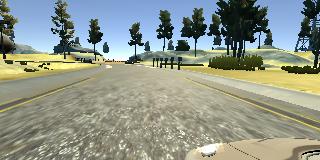The goals / steps of this project are the following:
- Use the simulator to collect data of good driving behavior
- Build, a convolution neural network in Keras that predicts steering angles from images
- Train and validate the model with a training and validation set
- Test that the model successfully drives around track one without leaving the road
- Summarize the results with a written report
My final model consisted of the following layers:
| Layer | Description |
|---|---|
| Normalized using Lambda | 160x320x1 'S' Channel Image from HSV |
| Cropping2D | Cropped Top 50, Bottom 20 pixels |
| Resize using Lambda | 128x128 Image |
| Conv2D | 4x4 stride, SAME padding, Kernel 8x8 |
| LeakyReLU | |
| Conv2D | 2x2 stride, SAME padding, Kernel 5x5 |
| LeakyReLU | |
| Conv2D | 2x2 stride, SAME padding, Kernel 5x5 |
| Flatten | |
| Dropout | 0.2 |
| LeakyReLU | |
| Dense | 512 |
| Dropout | 0.5 |
| LeakyReLU | |
| Dense | 1 |
To train the model, I used:
EPOCHS of 5,
BATCH SIZE of 128,
Optimizer 'Adam',
MSE loss function,
Train/Validation Split: 0.8/0.2
My first step was to use a convolution neural network model similar Nvidia End-to-End model. I thought this model might be appropriate because it is also used for Self-Driving Cars.
In order to gauge how well the model was working, I split my image and steering angle data into a training and validation set in ratio of 80/20.
I also tried LeNet model, both the models didn't gave me good results. I was getting low mean squared error on the training set but a high mean squared error on the validation set. This implied that the model was overfitting.
To combat the overfitting, I used all three cameras from the dataset.
I eventually switched to the model similar to the one used by commaai, later I modified it to get better results out of it.
The training dataset I used is Udacity dataset.
The final step was to run the simulator to see how well the car was driving around track one. There were a few spots where the vehicle fell off the track like curved lane line. To improve the driving behavior in these cases, I added flip image corresponding to each image.
Then I eventually switched to the different model.
I randomly shuffled the data set and put 20% of the data into a validation set.
The validation set helped determine if the model was over or under fitting. The ideal number of epochs was 2 as evidenced by better validation accuracy. I used an adam optimizer so that manually training the learning rate wasn't necessary.
At first, I trained the model using Udacity dataset, it worked fine except getting of the track at two specific spots. So, I retrained the model using model2.py using previous output model.h5, after training it outputs model2.h5.
Spot images from where car was getting off track:
| Offtrack Image 1 | Offtrack Image 2 |
|---|---|
 |
 |
For retraining the model I recorded image data by positioning the car when it's ready to go off-road and then steering towards the center.
video2.mp4 is output produced from model2.h5. It is the final output.
At the end of the process, the vehicle was able to drive autonomously for 1 lap.
Here's the images from 3 differrent cameras at same position:
| Left Camera | Center Camera | Right Camera |
|---|---|---|
 |
 |
 |
I converted the image to HSV using cv2 & only used S (Saturation) channnel from HSV (Hue, Saturation, Value). As lane lines can easily be identified using S channel.
| S Image | Flipped S Image |
|---|---|
 |
 |
Here, angle for the second image will be negative angle of the first image.